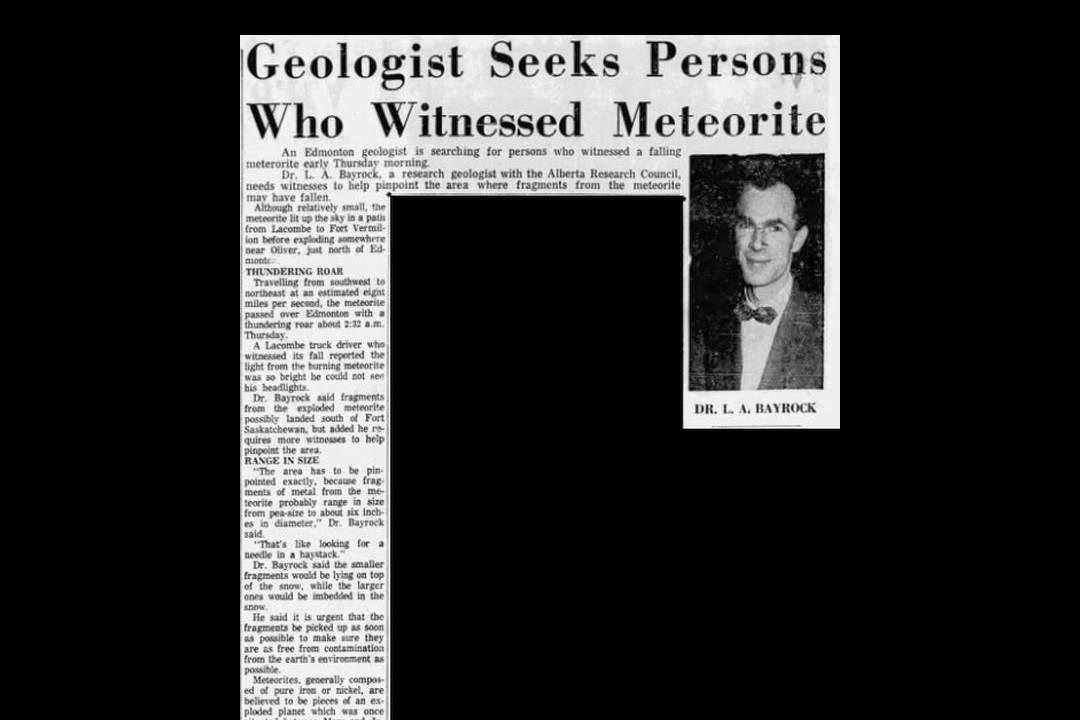On this day in 1965, an Edmonton geologist was on the hunt for a missing meteorite.
L.A. Bayrock had quite a task ahead of him. Only a handful of people had witnessed the meteorite blaze across the sky just after 2:30am a few nights before. One of the few to see it was a trucker on a late-night route, who claimed the meteor was so bright it overpowered his vehicle's headlights. Based on this account and others, Bayrock believed the space rock landed northeast of Edmonton and likely split into tiny pieces, reducing the chances of anyone spotting it in the snow.
It's difficult to determine if Bayrock ever found this particular meteorite. But, whether he did or didn't, the 1960s nonetheless proved to be an extremely meteorite-rich decade for Alberta. Seven separate meteorites were recovered in the province between 1960 and 1967. Three of them were discovered shortly after impact, and the other four were discovered from earlier falls. (For comparison, 88 official meteorites have been recovered in all of Canada, according to the International Society for Meteorites and Planetary Science.)
The missing meteorite wasn't even the only one Bayrock was tracking in 1965. He was part of a team that traced the path of a meteorite that passed over Edmonton and crashed near Revelstoke, British Columbia, just a week later on March 31.
Previously, Bayrock had also helped track down a grey chondrite meteorite found at a farm outside Peace River, roughly 500 kilometres northwest of Edmonton, in 1963. He also played a part in what is likely the most famous space rock to land in the Edmonton region. On the morning of March 4, 1960, a massive meteorite streaked over B.C. and Alberta, before an explosive landing outside Bruderheim, roughly 50 kilometres northeast of Edmonton. The impact reportedly rattled windows and shook people awake. Over the course of its flight, the meteorite showered the area with fragments. Afterward, dozens of people scoured the snow to collect the remains. In the end, more than 700 fragments were recovered, weighing more than 660 pounds. This set the record for the most pieces recovered from a single meteorite in Canada. That record was only broken in 2009, by another Alberta meteorite.
The Bruderheim meteorite's fragments may have been spread over the Edmonton area, but they've traveled even further over the past 60 years. The rock was the start of the meteorite collection at the University of Alberta, which is now the largest university-based collection in Canada. Samples from the Bruderheim meteorite have been donated or traded to other museums and scientific institutions, including the Smithsonian National Museum of Natural History, Cambridge University, and the Vatican Meteorite Collection.
But it is more than just an interesting-looking rock. The Bruderheim meteorite is potentially 4.6 billion years old, and research on the fragments has led to a better understanding of space radiation, as well as potential insights into the birth of our solar system.
Alberta isn't quite the target for extraterrestrial bombardment that it was in the 1960s. In December, a Mill Woods man found a tiny chunk of meteorite in his rain gutter, the first fall witnessed in Alberta since 1977.
Another of Alberta's meteorite falls was in the news recently. Manitou Asinîy, also known as the Manitou Stone, is an ancient 145-kilogram meteorite that fell in southern Alberta a very long time ago. It has held spiritual significance for several Indigenous communities and served as a gathering place — at least until it was dug up and carted off by one of Edmonton's earliest settlers. It currently is on display at the Royal Alberta Museum in downtown Edmonton. Two years ago, the Alberta government agreed to return the stone to the land, but as Taproot recently reported, that process continues.
This clipping was found on Vintage Edmonton, a daily look at Edmonton's history from armchair archivist @revRecluse of @VintageEdmonton.

